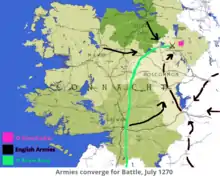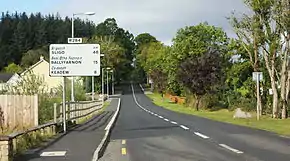Battle of Áth an Chip
Cath Áth an Chip, meaning the Battle of Ath an Chip", alias “Battle of Connacht", was a battle fought in 1270 between armies of the Kingdoms of Connacht and England at county Leitrim in Ireland. The result was a decisive Irish victory.[1] "Athanchip", then a ford marked by a tree-stump", is today the place called "Battle bridge". The battle site is probably Drumhierney townland and Leitrim village.
| Battle of Áth an Chip | |||||||
|---|---|---|---|---|---|---|---|
| Part of Norman invasion of Ireland | |||||||
_-_WGA24165.jpg.webp) Norman illustration from Bayeux Tapestry | |||||||
| |||||||
| Belligerents | |||||||
| Kingdom of Connacht |
| ||||||
| Commanders and leaders | |||||||
| Aedh mac Felim Ó Conchobair, Turlough O'Briain | Robert d'Ufford, Walter de Burgh | ||||||
| Strength | |||||||
| unknown | unknown | ||||||
| Casualties and losses | |||||||
| unknown | unknown | ||||||
Background
Fedlimid Ó Conchobair was King of Connacht during the Norman invasion of Ireland. He initially attempted to arrest the expansion of Norman settlements in Connacht, but eventually capitulated to King Henry II. His son Aedh did not favour the diplomatic approach. Even during his father's reign, Aedh attacked the Normans at every opportunity. In 1249 he ambushed Piers de Bermingham, who at the time held the wardship of the de Burgh lands. This ambush led to all-out war and resulted in Fedlimid being deposed.[2] He regained his throne in 1250 but was much weaker as a result.
Battle

Aedh became king after his father's death in 1265.[2] He continued to raid settled lands in his kingdom. In 1269 Robert d'Ufford, the new justiciar in Ireland, began building a royal castle in Roscommon. D'Ufford sent his deputy across the River Shannon to join his ally, Walter de Burgh, 1st Earl of Ulster. The combined forces met with Aedh to negotiate but to no avail. The forces under de Burgh retreated and attempted to ford the Shannon at Áth-an-Chip. Aedh routed the army and destroyed the castle at Roscommon.

The battle occurred at Maigh Nissi (Moynissy, "plain of Nissi"), in the barony of Leitrim, County Leitrim. Connellan states "Moy-Nisse was a district along the Shannon in the county of Leitrim, near Carrick-on-Shannon; and the events here narrated occurred about that place".[3] Moynissy was the Gaelic place name for the flat, unforested part, of the barony of Leitrim, bordering the Shannon.[4]
The Irish Annals describe the Anglo-Normans crossing Ath-Cara-Conaill ("Carrick-on-Shannon") before marching onward to Ath-an-cip.[3] Places corrupted as "Ath an Chip" and all variants were a ford marked by a large tree stump.[5][6] Ath an Chip was clearly a ford on the River Shannon. MacNamee states "where Ath an Chip was is not certain; to the present writer the evidence would seem to point to Battle Bridge".[7][8] At Leitrim village the R284 road crosses the Shannon at "Battle-bridge" (Irish: Béal Átha an Chatha, "the ford/mouth of the battle").[9][10] The townland at this bridge is Drumhierney (Irish: Droim Thiarnaigh, meaning the ridge of the "master", "lord", or "the domination").[n 1] Without certainty the battle-site was Drumhierney townland in county Leitrim.
Aftermath
The death of de Burgh in 1271 ended all effective resistance to Aedh's rule in Connacht. Aedh continued to raid as far east as Granard and even burnt Athlone, destroying the bridge there. The raiding came to an end with Aehd's sudden death on 3 May 1274.[2] The Kingdom of Connacht became embroiled in a civil war with thirteen kings during the period between 1274 and 1315.[2] This instability left Connacht vulnerable to Norman settlement.
See also
- Battle of Druim Dearg, 1260AD
- Battle of Ardnocher, 1329AD
References and notes
Notes
- "Tiarnaigh" means literally Rule (do, over), or dominate.[11] See wikt:tiarnaigh and Tierney.
Primary sources
- Mac Annaidh, S., ed. (2001). Illustrated Dictionary of Irish History. Dublin: Gill and Macmillan.
- Cosgrove, Art, ed. (2008). A new history of Ireland (1. publ. in paperb. ed.). Oxford: Oxford University Press. p. 249. ISBN 9780199539703.
- Connellan 1846, pp. 87.
- Connellan 1846, pp. 87,n=1.
- logainm, pp. 27909.
- logainm, pp. 22479.
- loganim, pp. 110012, Archival records.
- MacNamee 1954, pp. 206.
- logainm, pp. 110012.
- Duchas 1938, pp. 208.
- loganim, pp. 29352.
Secondary sources
- Connellan, Owen (1846). Philip MacDermott (ed.). The Annals of Ireland, translated from the original Irish of the four masters. O'Clery, Michael, 1575-1643 (electronic resource, Free eBook from the Internet Archive ed.). Dublin: B Geraghty, s. Anglesea street.CS1 maint: ref=harv (link)
- Tobin (2013). "Carrick-on-Shannon Sewerage Improvement Scheme, Environmental Impact Statement: Chapter 4, Material Assets - Cultural Heritage" (PDF) (electronic document ed.). Environmental Impact Agency. pp. 163–197.CS1 maint: ref=harv (link)
- Logainm. "Áth na gCeap".CS1 maint: ref=harv (link)
- logainm. "Áth Cip".CS1 maint: ref=harv (link)
- logainm. "Béal Átha an Chatha".CS1 maint: ref=harv (link)
- "Local Place Names - Battlenrodge". Duchas. 1938.CS1 maint: ref=harv (link)
- logainm. "Droim Thiarnaigh ("Drumhierney")".CS1 maint: ref=harv (link)
- MacNamee, James Joseph (1954). History of the Diocese of Ardagh. Dublin: Browne and Nolan.CS1 maint: ref=harv (link)
Further reading
- MacLochlainn, Noel (2020). Battle of Connacht 1270: Aedh O'Conchobar's victory at Áth an Chip. Conmaicne. ISBN 979-8616815262.CS1 maint: ref=harv (link)